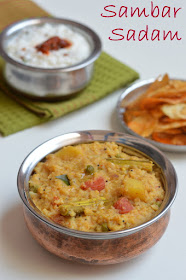Pulingari is tamarind based gravy that is served along steamed
rice and thoran/poriyal. I have already posted 2 variations of this pulingari
which I prepare regularly at home – the Podi Podicha Pulingari and the
Navarathri Pulingari. This Pulingari is different in the ground paste and also
it uses Karamani.
I came across this recipe in one of the FB groups, posted by
Lalitha Iyer. This tasted really good with rice. Even the kids enjoyed it. It
was a welcome change from the regular kootans that I prepare. Do try it and let
me know how you liked it.
Serves – 3 to 4
What you’ll need
- Vazhakkai – 2 cup, diced into small cubes
- Karamani/Thatta Payaru/Cowpeas – ½ cup
- Tamarind – a small lemon sized ball
- Turmeric Powder – ¼ tsp
- Jaggery – 1 tsp (optional)
- Asafoetida – a generous pinch
- Salt to taste
- Curry Leaves – 5 to 6
To Grind
- Coconut – ½ cup, tightly packed
- Dried Red Chilly – 2 or 3 (adjust according to taste)
- Cumin Seeds – 1 tsp
To Temper
- Coconut Oil – 1 tsp
- Mustard Seeds – ½ tsp
- Urad Dal – ½ tsp
- Curry Leaves – 10 to 15 leaves
Method
- Soak the Karamani for about 10 mins in water and then pressure cook the karamani with just enough water.
- Also pressure cook or steam the vazhakkai pieces with little turmeric powder and salt. Don’t add too much water to this.
- Soak the tamarind in 1 cup of water, squeeze and extract the pulp and discard the fibers. Add another cup of water to this and make it around 2 cups.
- Transfer the tamarind extract into a vessel, add turmeric powder, asafoetida, salt and jaggery, if using and few curry leaves. Once it starts boiling add the vazhakkai pieces and karamani and let it boil for 6 to 8 minutes or till the raw smell of the tamarind disappears.
- In the meantime, grind the coconut along with the red chilly and cumin seeds, into a smooth paste using about ½ cup of water.
- Add this ground paste to the boiling tamarind and vegetable mixture, add more water if required to adjust the consistency. Should be slightly thicker than the Sambar. Simmer for couple of minutes.
- Remove from heat.
- Heat a small frying pan with oil, add mustard seeds, once they splutter add urad dal and fry till they turn golden brown, add the curry leaves and pour the tempering over the pulingari.
Delicious pulingari is ready.
Serve alongwith steamed white rice and Keerai masiyal or
with any thoran/poriyal.
Note:
- You can cook the vazhakkai pieces in the tamarind water. I pressure cooked it.
- Don't use too much water to pressure cook the Karamani and vazhakkai pieces. If there is too much water, then reserve the water and add to the pulingari if required at the end, else the pulingari will become very watery.
- The jaggery is optional, I used it as it balances out the tang from the tamarind.
- Using coconut oil for tempering gives a good flavor, but you can use any regular vegetable oil too.











